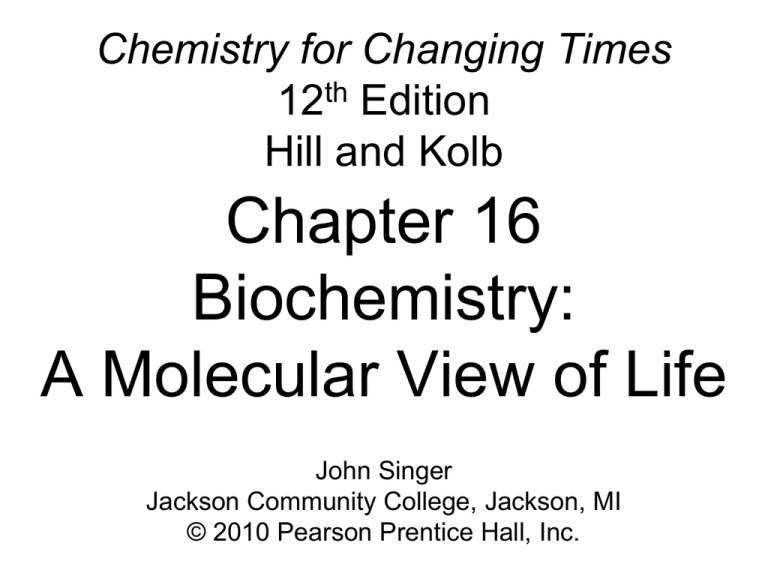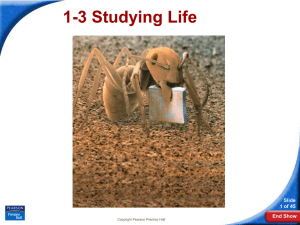
Chemistry for Changing Times
12th Edition
Hill and Kolb
Chapter 16
Biochemistry:
A Molecular View of Life
John Singer
Jackson Community College, Jackson, MI
© 2010 Pearson Prentice Hall, Inc.
The Living Cell
Biochemistry is the
chemistry of living
things and life
processes.
© 2010 Pearson Prentice Hall,
Inc.
16/2
The Living Cell
The basic structural unit of all living organisms is
the cell.
All cells are enclosed in a cell membrane,
which regulates the passage of nutrients and
wastes.
In addition to a cell membrane, plant cells are
surrounded by a cell wall composed of
cellulose.
© 2010 Pearson Prentice Hall,
Inc.
16/3
The Living Cell
Nucleus: The largest structure within the cell. The nucleus
contains the genetic material that controls heredity.
Ribosomes: The structure where protein synthesis occurs.
Mitochrondria: The cell structure where energy production
occurs.
Chloroplasts: Found only in plant cells. In the
chloroplasts, photosynthesis occurs.
© 2010 Pearson Prentice Hall,
Inc.
16/4
The Living Cell
Plant Cell
© 2010 Pearson Prentice Hall,
Inc.
16/5
The Living Cell
Animal Cell
© 2010 Pearson Prentice Hall,
Inc.
16/6
Energy in Biological Systems
Green plants contain chloroplasts, which are capable of
taking the radiant energy of the sun and storing it as
chemical energy in glucose molecules.
6 CO2 + 6 H2O → C6H12O6 + 6 O2
Plant cells can also convert carbohydrate molecules to fat
molecules, and some are even capable of converting them
to proteins.
Animals cannot produce their own energy. They must
obtain such energy by eating plants or other animals that
eat plants.
© 2010 Pearson Prentice Hall,
Inc.
16/7
Energy in Biological Systems
Metabolism is defined as the series of
chemical reactions that keep a cell alive.
Metabolic reactions are divided into two
categories:
1. Catabolism: The process of breaking
down molecules to produce energy.
2. Anabolism: The process of synthesizing
molecules.
© 2010 Pearson Prentice Hall,
Inc.
16/8
Carbohydrates
Carbohydrates are polyhydroxy aldehydes or
ketones or compounds that can be hydrolyzed to
form such compounds.
Monosaccharides: Carbohydrates that cannot
be hydrolyzed into simpler compounds.
© 2010 Pearson Prentice Hall,
Inc.
16/9
Carbohydrates
Monosaccharides: Carbohydrates that cannot
be hydrolyzed into simpler compounds.
© 2010 Pearson Prentice Hall,
Inc.
16/10
Carbohydrates
Most monosaccharides actually exist in cyclic
form.
© 2010 Pearson Prentice Hall,
Inc.
16/11
Carbohydrates
Disaccharides consist of molecules that can be
hydrolyzed into two monosaccharide units.
© 2010 Pearson Prentice Hall,
Inc.
16/12
Carbohydrates
Polysaccharides are composed of large
molecules that can be hydrolyzed into many
monosaccharide units. Examples include starch,
cellulose, and glycogen.
© 2010 Pearson Prentice Hall,
Inc.
16/13
Carbohydrates
Both starch and
cellulose are
polymers of glucose.
The linkages
between glucose
molecules in starch
are alpha (α)
linkages, whereas in
cellulose they are
beta (β) linkages.
© 2010 Pearson Prentice Hall,
Inc.
16/14
Carbohydrates
Cellulose makes up the
structural units of plants.
Cellulose chains are
composed of parallel
bundles called fibrils.
© 2010 Pearson Prentice Hall,
Inc.
16/15
Carbohydrates
Starch is composed of two polymers, amylose
and amylopectin. In amylose, the glucose
molecules are connected in long parallel chains.
In amylopectin, the chains are branched.
© 2010 Pearson Prentice Hall,
Inc.
16/16
Carbohydrates
Glycogen is known
as animal starch. It is
similar to amylopectin
in that the glucose
polymers are
branched.
© 2010 Pearson Prentice Hall,
Inc.
16/17
Fats and Other Lipids
Lipids are biological molecules that are
insoluble in water, but are soluble in nonpolar
organic solvents.
Fats are esters of long-chain fatty acids and
glycerol. Fats are often called triglycerides or
triacylglycerols.
© 2010 Pearson Prentice Hall,
Inc.
16/18
Fats and Other Lipids
Fatty Acids
© 2010 Pearson Prentice Hall,
Inc.
16/19
Fats and Other Lipids
Palmitic Acid
© 2010 Pearson Prentice Hall,
Inc.
16/20
Fats and Other Lipids
Triglycerides
are triesters of
glycerol and
fatty acids.
© 2010 Pearson Prentice Hall,
Inc.
16/21
Fats and Other Lipids
Saturated fatty acids have no carbon-to-carbon
double bonds.
Monounsaturated fatty acids have one carbonto-carbon double bond.
Polyunsaturated fatty acids have two or more
carbon-to-carbon double bonds.
© 2010 Pearson Prentice Hall,
Inc.
16/22
Fats and Other Lipids
Solid fats have a high proportion of saturated
fatty acids.
Liquid oils have only unsaturated fatty acids.
© 2010 Pearson Prentice Hall,
Inc.
16/23
Fats and Other Lipids
Iodine number is a measure of the degree of
unsaturation of a fat or oil. Iodine number is the
number of grams of I2 that are consumed by 100
g of a fat or oil.
© 2010 Pearson Prentice Hall,
Inc.
16/24
Fats and Other Lipids
Iodine Number
© 2010 Pearson Prentice Hall,
Inc.
16/25
Proteins
Proteins are a vital
component of all
living things.
© 2010 Pearson Prentice Hall,
Inc.
16/26
Proteins
Proteins are polymers
of amino acids.
Amino acids contain
both an amine and
carboxylate group
attached to the same
carbon called the
alpha carbon.
© 2010 Pearson Prentice Hall,
Inc.
16/27
Proteins
Amino Acids
© 2010 Pearson Prentice Hall,
Inc.
16/28
Proteins
Amino acids tend
to exist as a
dipolar ion or
inner ion at
physiological pH.
Such an ion is
called a
zwitterion.
© 2010 Pearson Prentice Hall,
Inc.
16/29
Proteins
Plants can synthesize proteins from carbon
dioxide, water, and minerals like nitrates or
sulfates.
Animals must consume proteins as part of their
diet.
Humans can synthesize some amino acids, but
must obtain essential amino acids in a normal
diet.
© 2010 Pearson Prentice Hall,
Inc.
16/30
The Peptide Bond
Amino acids are linked to each other to form
proteins by an amide linkage between the
amine of one amino acid to the carboxylate of
another amino acid. This amide linkage is known
as the peptide bond.
© 2010 Pearson Prentice Hall,
Inc.
16/31
The Peptide Bond
Dipeptide is formed when two amino acids are
joined.
Tripeptides contain three amino acid units.
Polypeptides contain ten or more amino acid
units.
Proteins may contain 10,000 or more amino
acid units.
© 2010 Pearson Prentice Hall,
Inc.
16/32
The Peptide Bond
The sequence of the amino acids in a protein is
critical. The sequence is always denoted from
the free amino group (N-terminal) to the free
carboxyl group (C-terminal).
© 2010 Pearson Prentice Hall,
Inc.
16/33
Structure of Proteins
Primary structure: The primary structure of a
protein is simply the sequence of amino acids
from N-terminal to C-terminal.
Example: The primary structure of angiotensin II
is:
Asp-Arg-Val-Tyr-Ile-His-Pro-Phe
© 2010 Pearson Prentice Hall,
Inc.
16/34
Structure of Proteins
Secondary structure: How the polypeptide
chain folds and coils due to hydrogen bonding of
the backbone amide groups. Examples include
the alpha helix and beta-pleated sheet.
© 2010 Pearson Prentice Hall,
Inc.
16/35
Structure of Proteins
Alpha Helix
© 2010 Pearson Prentice Hall,
Inc.
16/36
Structure of Proteins
Beta-Pleated Sheet
© 2010 Pearson Prentice Hall,
Inc.
16/37
Structure of Proteins
Tertiary structure:
The threedimensional shape of
a protein due to the
spatial relationships
of groups that are far
apart on the protein
chain. One example
is the protein chain in
globular proteins.
© 2010 Pearson Prentice Hall,
Inc.
16/38
Structure of Proteins
Quaternary
structure: Involves
the interaction of
more than one
peptide chain.
© 2010 Pearson Prentice Hall,
Inc.
16/39
Structure of Proteins
Four Ways to Link Protein Chains
1. Hydrogen bond: The secondary structures occur when
hydrogen bonds are formed between amide nitrogen (N-H) and
carboxyl oxygen (C=O). Tertiary structures also involve
hydrogen bonding between side chains of the amino acids.
2. Ionic bonds: Sometimes called salt bridges. These occur
between oppositely charged side chains.
3. Disulfide linkages: When two cysteine side chains are
oxidized, a (-S-S-) disulfide linkage can form.
4. Dispersion forces: These are attractive forces between two
nonpolar side chains.
© 2010 Pearson Prentice Hall,
Inc.
16/40
Structure of Proteins
© 2010 Pearson Prentice Hall,
Inc.
16/41
Enzymes
Enzymes are biological catalysts. Most are
proteins. Many are highly specific, only
catalyzing a single reaction or related group of
reactions. The substrate is the reactant
molecule whose reaction the enzyme catalyzes.
© 2010 Pearson Prentice Hall,
Inc.
16/42
Enzymes
The activity of many enzymes can be explained
by the induced fit model. According to the
induced fit model, the substrate molecule
bonds to the enzyme at the active site, forming
an enzyme-substrate complex. This complex
can then catalyze the reaction of the substrate
and form products.
Enzyme + Substrate → Enzyme-substrate
complex ↔ Enzyme + Products
© 2010 Pearson Prentice Hall,
Inc.
16/43
Enzymes
Induced Fit Model
© 2010 Pearson Prentice Hall,
Inc.
16/44
Enzymes
Inhibition
The action of enzymes can be inhibited. One
mechanism of enzyme inhibition has a molecule
bonding to the enzyme protein at another site
other than the active site. This changes the
shape of the protein and prevents the substrate
from bonding at the active site. This mechanism
is used to control the action of certain enzymes.
© 2010 Pearson Prentice Hall,
Inc.
16/45
Enzymes
Inhibition
© 2010 Pearson Prentice Hall,
Inc.
16/46
Enzymes
Cofactors: Some enzymes require another
molecule to be present for proper functioning of
the enzyme. Cofactors can be inorganic ions
(Zn2+, Mg2+, …) or organic molecules.
Coenzyme: A cofactor that is a nonprotein
organic molecule.
Apoenzyme: The pure protein part of an
enzyme.
© 2010 Pearson Prentice Hall,
Inc.
16/47
Enzymes in Medicine
Diabetic test strips use two enzymes to measure blood
sugar. One enzyme catalyzes the oxidation of glucose,
producing hydrogen peroxide as a by-product. The other
enzyme catalyzes the breakdown of hydrogen peroxide and
oxidizes a dye to produce a color change.
Enzymes can be monitored to diagnose liver damage or
heart damage.
Enzymes can also be used to break up clots after a heart
attack or to increase clotting to treat hemophelia.
© 2010 Pearson Prentice Hall,
Inc.
16/48
Enzymes in Industry
Enzymes have many industrial applications,
including the production of baby foods, beer,
sweeteners for soft drinks, animal feeds, and
blue jeans.
© 2010 Pearson Prentice Hall,
Inc.
16/49
Enzymes and Green Chemistry
Enzymes are being investigated for producing
specialty chemicals and new drugs.
In addition, enzymes can be used to break down
complex pollutants.
© 2010 Pearson Prentice Hall,
Inc.
16/50
Enzymes in Everyday Life
Enzymes are used in stain removers and meat
tenderizers. Those that are lactose-intolerant
can also take enzymes to reduce the discomfort
caused by ingesting dairy foods. Worldwide
production of enzymes is worth more than $1
billion per year.
© 2010 Pearson Prentice Hall,
Inc.
16/51
Nucleic Acids
Nucleic acids serve as the information and
control centers of the cell. They are in two major
forms: deoxyribonucleic acid (DNA) and
ribonucleic acid (RNA). Both consist of long
chains called nucleotides. Each nucleotide is
composed of a sugar unit, phosphate unit, and a
heterocyclic amine base.
© 2010 Pearson Prentice Hall,
Inc.
16/52
Nucleic Acids
© 2010 Pearson Prentice Hall,
Inc.
16/53
Nucleic Acids
Nucleotides are
composed of a sugar,
phosphate, and an
amine base.
© 2010 Pearson Prentice Hall,
Inc.
16/54
Nucleic Acids
DNA consists of a
double helix.
© 2010 Pearson Prentice Hall,
Inc.
16/55
Nucleic Acids
The double helix of DNA is held together by basepairing. Complimentary bases are thymine and
adenine, and cytosine and guanine. These
complimentary bases are held together by hydrogen
bonding.
© 2010 Pearson Prentice Hall,
Inc.
16/56
Nucleic Acids
Structure of RNA
RNA consists of single strands of nucleic acid.
© 2010 Pearson Prentice Hall,
Inc.
16/57
DNA: Self-Replication
Chromosomes: Threadlike bodies of DNA that
are tightly coiled into x-shaped bodies. Human
body cells contain 46 chromosomes. Twentythree come from the egg of the mother, 23 come
from the sperm of the father.
Gene: Section of a DNA molecule that controls
the synthesis of protein.
Replication: Copying of DNA during cell division.
© 2010 Pearson Prentice Hall,
Inc.
16/58
DNA: Self-Replication
© 2010 Pearson Prentice Hall,
Inc.
16/59
RNA: Protein Synthesis and the
Genetic Code
The genetic code is carried in a three-base
sequence known as a codon.
© 2010 Pearson Prentice Hall,
Inc.
16/60
RNA: Protein Synthesis and the
Genetic Code
During protein synthesis, the genetic information of DNA
is transferred to RNA by a process known as
transcription. During transcription, messenger RNA
(mRNA) is synthesized.
© 2010 Pearson Prentice Hall,
Inc.
16/61
RNA: Protein Synthesis and the
Genetic Code
The genetic code is carried on a sequence of
three bases known as a codon. The codon
codes for a specific protein by base-pairing the
anticodon with a specific transfer RNA (tRNA)
through a process known as transcription.
© 2010 Pearson Prentice Hall,
Inc.
16/62
RNA: Protein Synthesis and the
Genetic Code
Transcription
© 2010 Pearson Prentice Hall,
Inc.
16/63
The Human Genome
Genetic Testing
One DNA sequencing technique is known as
polymerase chain reaction (PCR). In the PCR
technique, the DNA is cleaved by enzymes;
bacterial enzymes called DNA polymerases are
used to multiply the amount of DNA fragments.
The fragments are separated from longest to
shortest and a “print” is obtained.
© 2010 Pearson Prentice Hall,
Inc.
16/64
The Human Genome
Recombinant DNA is DNA that is produced
artificially and contains DNA from two different
sources. In one technique, restriction enzymes
are used to cleave the DNA. The DNA fragments
can then be inserted into bacterial plasmids and
the plasmid inserted into a host organism. There
it replicates, producing exact copies of itself.
© 2010 Pearson Prentice Hall,
Inc.
16/65
The Human Genome
Recombinant DNA
© 2010 Pearson Prentice Hall,
Inc.
16/66
The Human Genome
Gene therapy involves introducing a functioning
gene into a person’s cells to correct the action of
a defective gene. Viruses are used to carry the
DNA into cells. Gene therapy is still
experimental.
© 2010 Pearson Prentice Hall,
Inc.
16/67
The Human Genome
Controversy and
Promise in Genetic
Engineering
Cloning of animals and
plants holds much
promise for food
production and treatment
of disease. There is also
much controversy and
concern.
© 2010 Pearson Prentice Hall,
Inc.
16/68






